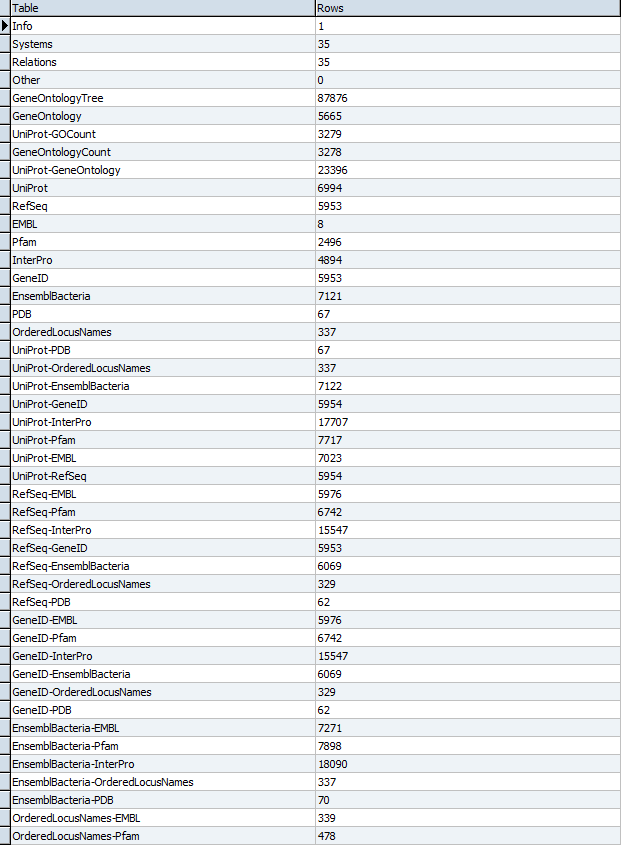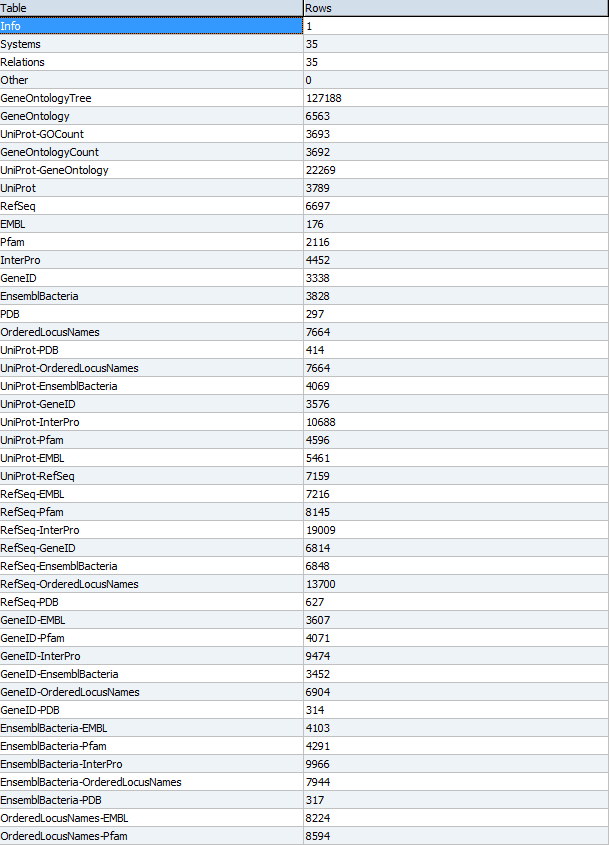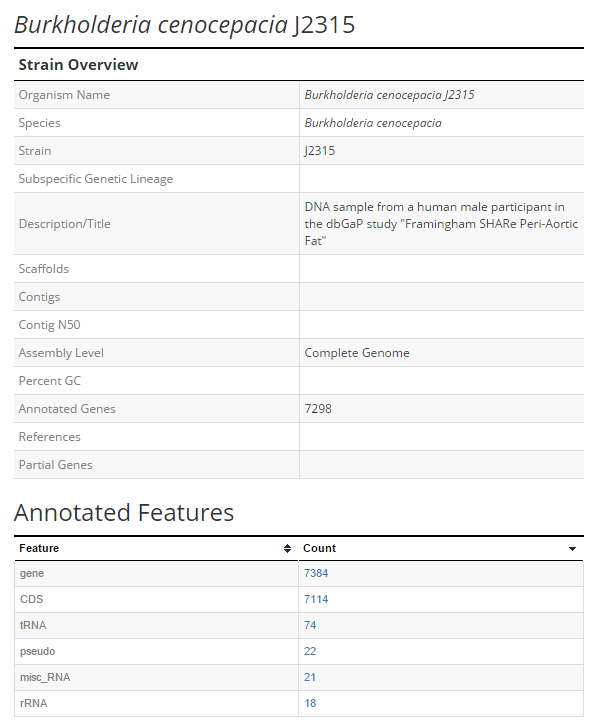GÉNialOMICS Gene Database Testing Report (Initial Export)
Contents
- 1 Export Information
- 2 Using TallyEngine
- 3 Using XMLPipeDB match to Validate the XML Results from the TallyEngine
- 4 Using SQL Queries to Validate the PostgreSQL Database Results from the TallyEngine
- 5 OriginalRowCounts Comparison
- 6 Visual Inspection
- 7 .gdb Use in GenMAPP
- 8 Compare Gene Database to Outside Resource
Export Information
Version of GenMAPP Builder: 3.0.0-build-5
Computer on which export was run: Home Workstation
Postgres Database name: B.cenocepacia_J2315_20151119_gmb3build5
UniProt XML filename: uniprot-taxonomy%3A216591_GEN_BL12_20151119.xml
- UniProt XML version: UniProt release 2015_11 - November 11, 2015
- UniProt XML download link: UniProtKB link for the complete proteome of J2315
- Time taken to import: 3.40 minutes
- Note: No issues were found with the import of this file.
GO OBO-XML filename: go_daily-termdb_GEN_BL12_20151119.obo-xml
- GO OBO-XML version (derived from the date modified on the file, itself): Date Modified: 11/19/2015 2:24 AM
- GO OBO-XML download link: Link from GO website
- Time taken to import: 5.23 minutes
- Time taken to process: 3.83 minutes
- Note: No issues were found with the import of this file.
GOA filename: 31277.B_cepacia_GEN_BL12_20151119.goa
- GOA version: Date Modified: 11/10/15, 1:47:00 PM (information sourced from FTP site)
- GOA download link: FTP site file
- Time taken to import: 0.04 Minutes
- Note: No issues were found with the import of this file.
Name of .gdb file: Bc-Std_GEN_BL12_20151119.gdb
- Time taken to export: 2 hour 29 minutes
- Start time: 6:31
- End time: 9:00
- Note: File was exported without any major issues, however, the export appeared to take considerably longer than the one that was conducted for Vibrio cholerae (took more than an hour longer). Possible explanations include the fact that: B. cenocepacia strain J2315 has a larger proteome/genome (6993 proteins associated with J2315 proteome, compared to the 3784 of V. cholerae), a different computer was utilized for the export (Home Workstation instead of the Seaver 120 Workstation). GenMAPP builder is also not modified to specifically work with the J2315 genes/IDs; this could have also impacted the time that it took for the export to complete. It was also noticed that the produced .gdb file was smaller than the one that was created for V. cholerae.
Using TallyEngine
- PostgreSQL was initialized through pgAdmin III and the database B.cenocepacia_J2315_20151119_gmb3build5 was left running
- GenMAPP builder was booted and Run XML and Database Tallies for UniProt and GO was selected under the Tallies menu item; the UniProt XML and GO files that were imported were chosen
- Results of TallyEngine:
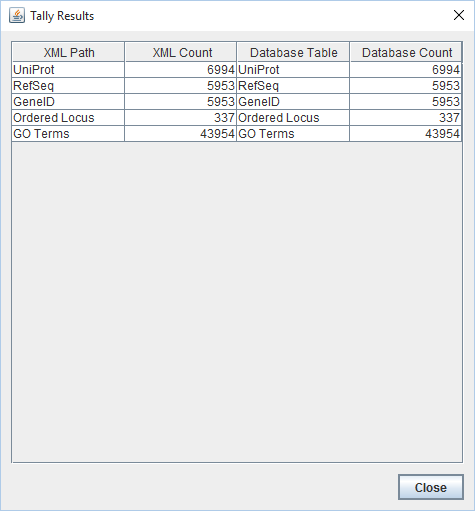
- Note: UniProt, RefSeq, GeneID, GO Terms, and Ordered Locus counts in the XML matched the ones in the Postgres database. RefSeq counts matched those of GeneID. Only 337 Ordered Locus counts were identified in the XML and the database (appears to be very low considering that each coding sequence has its own OrderedLocusName). It appears that all data was successfully imported except the Ordered Locus names (it appears that the import did not proceed correctly and it appears that genMAPP builder is not identifying some data within the XML file; a modification of the program could fix this)
Using XMLPipeDB match to Validate the XML Results from the TallyEngine
- The Windows command line was launched (cmd.exe)
- This set of commands was inputted into the command line in order to utilize XMLPipeDB match to verify the OrderedLocusNames count:
java -jar xmlpipedb-match-1.1.1.jar "p?BCA[A-Z]?[0-9][0-9][0-9][A-Z]?[0-9]?[A-Z, a-z]?" < uniprot-taxonomy%3A216591_GEN_BL12_20151119.xml- This command was created with the found gene patterns in mind; the patterns are further explained in the Week 12 journal
- NOTE: Prior to executing the command, the folder that held the files and xmlpipedb-match-1.1.1.jar was entered through the Windows command line (a set of CD commands was used in order to enter the correct directory)
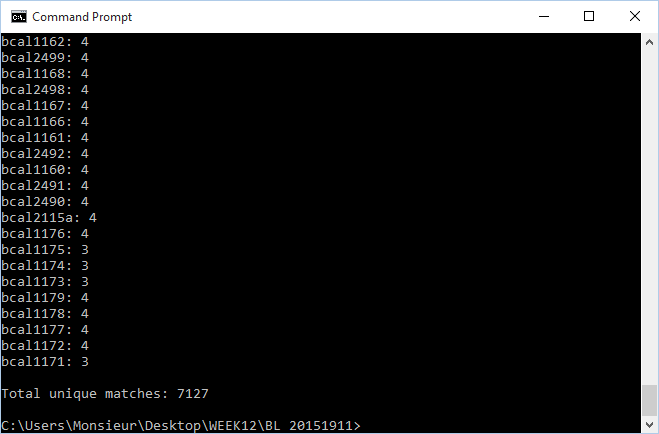
- 7127 unique matches were found through XMLPipeDB match
Are your results the same as you got for the TallyEngine? Why or why not?
- These results are very different from what was found through TallyEngine. TallyEngine reported 337 items for OrderedLocusNames while 7127 matches were found through the Match command. The large difference lends more weight to the possibility that GenMAPP builder is not recognizing most of the terms as OrderedLocusNames.
Using SQL Queries to Validate the PostgreSQL Database Results from the TallyEngine
- pgAdmin III was booted and all of the necessary connections were made
- It was realized that the gene/name tags in the XML file end up in the genenametype table (source: the wiki page regarding database quality analysis
- In pgAdmin III, the query
select count(*) from genenametype where type = 'ordered locus' and value ~ 'p?BCA[A-Z]?[0-9][0-9][0-9][A-Z]?[0-9]?[A-Z, a-z]?';was issued via the SQL Query menu in order to validate the PostgreSQL Database Results according to TallyEngine- 0 unique matches were found in pgAdmin III (postgres database results). It is possible that the command was not interpreted properly by PSQL but it also a possibility that the import did not proceed properly and the tables were not fully populated with all of the OrderedLocusNames present in the XML.
select count(*) from genenametype where type = 'ordered locus'was executed as a query to verify, oncemore, the entries present in the genenametype table- A count of 337 was given, which is the same number that was found through TallyEngine
select * from genenametype where type = 'ordered locus'was executed in order to take a look at the rows/columns that are within the GeneNameType table
- It was noticed that the OrderedLocusNames values are not in the format that was being tested for earlier. The format is
BceJ2315_#####instead ofp?BCA[A-Z]?[0-9][0-9][0-9][A-Z]?[0-9]?[A-Z, a-z]?; these two formats are discussed in the Week 12 Assignment
- It was noticed that the OrderedLocusNames values are not in the format that was being tested for earlier. The format is
Are your results the same as reported by the TallyEngine? Why or why not?
- These results are the same as reported by the TallyEngine, however, it seems that these results are not indicative of a proper data import. It appears that most of the data tied to other orderedlocusnames formats was not imported into the database and was not taken into account by TallyEngine.
- Further match testing was also conducted through the use of
java -jar xmlpipedb-match-1.1.1.jar "BceJ2315_[0-9][0-9][0-9][0-9][0-9]?" < uniprot-taxonomy%3A216591_GEN_BL12_20151119.xmlwith the windows command line. This command yielded 338 results which is one off from what was seen with TallyEngine and the SQL queries; it also suggests that only the "BceJ2315_#####" data was imported (most of the data is tied to the other gene name format)
- Further match testing was also conducted through the use of
OriginalRowCounts Comparison
- The newly created J2315 .gdb file was opened with a program that is able to explore a .mdb file (such as Microsoft Access); in this case, MDB Viewer Plus was utilized.
- Using the program, the OriginalRowCounts table was looked at, which contained summaries regarding each of the tables within the database (and the # of rows/entries in each of the tables)
- OriginalRowCounts for Initial Export of J2315
- It was decided that a good reference or "benchmark" would be the database that was last created for V.cholerae using data from 2015; comparing the two should bring to light any glaring differences (which can be indicative of a poor export)
- Benchmark .gdb file: compressed Vc-Std_20151027_BL.gdb
- OriginalRowCounts for 2015 Database for V. cholerae
Note: Firstly, it was noticed that all of the same tables are present within each of the two databases. It was noticed that, in the J2315 database, all of tables involving OrderedLocusNames had extremely fewer entries than those same tables in the 2015 Vibrio database; this big difference is suggested to be the result of how GenMAPP builder handled the input files (XML, GOA, OBO-XML) and not due to any differences between the two species (such extreme variation would not be expected). In the 2015 Vibrio database, the number of OrderedLocusNames entries was similar to the number in the UniProt table (the number appears to be double the entries since that database took into account two different formats of the same data). Since the J2315 database has 6993 within the UniProt table, it is expected that a proper import would result in OrderedLocusNames row numbers that are not too far from 6993.
Visual Inspection
Perform visual inspection of individual tables to see if there are any problems.
- Look at the Systems table. Is there a date in the Date field for all gene ID systems present in the database?
- Yes, there are dates present for GeneOntology, InterPro, GeneID, RefSeq, UniProt, EMBL, PDB, Pfam, OrderedLocusNames, and EnsemblBacteria.
- Open the UniProt, RefSeq, and OrderedLocusNames tables. Scroll down through the table. Do all of the IDs look like they take the correct form for that type of ID?
- In the UniProt table, it appears that the ID and EntryName columns involve the correct ID form for J2315. The GeneName column in UniProt, however, appears to be missing most of its entries. No gene names in the basic form of BCA[S,L,M]#### and BceJ2315_##### can be found. Very few gene names are present, and those present are in the form of either four letters with the final letter being capital or in the form of three uncapitalized letters.
- RefSeq table appears to be in order
- OrderedLocusNames table, as suggested by earlier analysis, only contains 337 rows and IDs in the format of BceJ2315_#####.
Note: It is apparent that there are several issues with the UniProt and with the OrderedLocusNames table. Both tables appear to be either missing entries or row data.
.gdb Use in GenMAPP
Note: This will be conducted for future exports.
Compare Gene Database to Outside Resource
Outside Resource: Burkholderia Genome DB
- The strain page for J2315 was looked up: [1]
- Only 337 OrderedLocusNames IDs were found in the exported database; 7384 annotated genes, however, are present in the MOD
Note: A lot more OrderedLocusNames IDs should be present in the exported database than the counts that were found. Data on the MOD and executed Match queries help confirm this. Current number of OrderedLocusNames (337) is very far from the numbers that was seen in the MOD (7384 annotated genes, with 7114 involved with the coding of protein)
